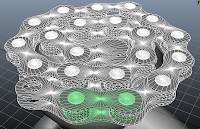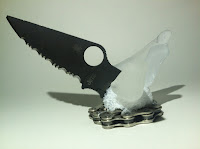Artist Research Project
Artists have the ability to show the viewer different ways to view the world. Some choose to alter how we see the world, while others create entirely new worlds. Two artists that create these new worlds and alter how we see the world are Larry Carlson and Yoshi Sodeoka.
Larry
Carlson is a multimedia contemporary artist who works out of New York City.
He works in a large variety of mediums
including traditional paper collages, programming, digital photo manipulation,
flash video, interactive pictures, gif images, movies, and sound effects.
Before being introduced to digital media he
created images in a similar style by cutting and pasting images he found in
books and magazines (
F.A.Q.). He is inspired from many sources including
psychedelics, cryptozoology, the occult and the paranormal (Art Uncovered).
In an interview he described on of his most influential
events as when he took a large dose of LSD on a mountain and met “mountain
gods” who have been giving him artistic ideas and inspiration ever since (Art Uncovered).
Carlson also gets a lot of inspiration from
ancient cultures such as the Ancient Egyptians, The Native Americans, and particularly
the Mayans. Carlson has spent a good amount of time exploring ancient Mayan
ruins all over the Yucatan peninsula.
Carlson’s
influences from these ancient cultures is very prevalent in his work, he often includes
pictures of humans with animal heads and strange combinations of animals in a
cave painting like fashion (Graphic Artwork).
Carlson usually creates his artwork in small
sections at a time, rarely having a set vision for a piece.
Because he works in this way, it can
sometimes take him up to several months for all the pieces to come together in
the finished piece.
“Red Hawk
Barn” is a flash video that viewers can interact with by moving their mouse
around and clicking on different objects in the landscape.
This video features a red barn with
snowflakes moving around the scene as well as music/sound effects created by
Carlson.
Some of the features of this interactive video include: If you click on the sky to the
left of the barn
you are thrown into a
world of flashing colors for a few seconds, then a symbol of a bird appears and
you are back to the barn.
If you move
your mouse to the bottom left of the screen an image of a woman with a hawk
head appears, if you click on this figure, you are taken to a different scene
with a bubble-like pattern for the ground that has pictures of clouds on
it.
Small space ships fly over these
bubbles and then words “Sky Land 7” quickly flash on and off the screen, then
taking you back to the red barn.
When
you move your mouse to the top right corner of the screen an image of a
snowflake appear, as well as a color changing bird in the cut-out on the
barn.
Clicking on the snowflake will
make an image of a spinning snowflake appear on the screen with a voice saying
“there was once a flake of snow” after which you are taken back to the scene
with the barn.
Many if not all of the
elements in this video seem random with the only overarching theme being that
of the hawk and the snow.
Creating unanswered
questions is a common thing that Carlson does in his artwork which I believe is
an essential part to his psychedelic style.
By introducing elements that don’t necessarily have purpose or explanation,
he makes the viewer wonder and keep searching through the work for an explanation.
Another way that he goes about exhibiting his psychedelic style is through
rapidly changing colors which can be seen when you click on the water drops
when you move you mouse near the door to the barn.
In an interview he said he “wanted to create
an interactive digital drug” (Art Uncovered), an ambition that I think he successfully
accomplished.
Yoshi
Sodeoka is a digital media artist from Yokohama, Japan. Sodeoka now lives and
works out of New York City. Sodeoka studied art and design at the Pratt
Institue in New York and was the founding art director of
Word Magazine (Bio, Contact Info, Press, CV.).
The majority of Sodeoka’s works are
psychedelic still images and videos that rely on shifting colors and geometric patterns,
instead of creating new psychedelic worlds such as Carlson does. Sodeoka often lacks a theme in his work, usually creating overwhelmingly colorful images that are distorted beyond recognition of the original image.
In “ASCII Bush”, Sodeoka puts George H. W.
Bush’s and George W. Bush’s State of the Union addresses through a visual text
filter. With this filter the audience sees the images of the addresses as
colored text against a black background. He also uses an audio filter to
distort the videos’ soundtracks. Although these videos are visually similar,
Sokeoka creates a substantially different atmosphere by using different audio
filters. In the video of Bush Sr.’s address, Sodeoka uses a harsh audio filter,
which makes him sound like an evil droid off of Star Wars. The sound of the
crowd cheering turns into an unsettling electronic buzz. In Bush Jr.’s video,
Sodeoka uses a much less threatening auto-tune-like filter. This filter makes
the sound of the crowd cheering into a glittery ringing noise. These audio
filters bring different connotations to the veiwer. While the video of George
Sr. sounds dark and scary, the video of Bush Jr.’s State of the Union Address
is lighter and whimsical. Sodeoka also uses color to create different
atmospheres in his videos. Using red text to accompany the harsh filter of Bush
Sr. video helps create a more negative vibe for the viewer. The blue text along
with the light auto-tune audio filter gives a calmer and less agitating vibe.
Another thing that may contribute to the differing atmosphere is the original
content of the presidential speeches. Bush Sr.’s address is about the grim
details of war in Operation Desert Storm, while Bush Jr.’s addresses lighter
topics such as tax reform, health care, and employment.
It is
important for the viewer to understand some of the important aesthetic
decisions behind Sodeoka’s “ASCII Bush”. Sodeoka includes the multiple
defintions of the word “recycle”, hinting at his intent of recycling old media
to make new art. One of the ways Sodeoka recycles these videos is by not
editing the original video. Sodeoka explains, “
The speeches are not
edited--just digitally filtered. And like I said, they are very lengthy. ASCII
BUSH is definitely boring enough to be interesting!!!” (ASCII Bush, 2004). By using filters instead of editing, Sodeoka
is able to preserve the original content, but creates a new experience for the
viewer.
Both of these artists
recycle old media sources to create new art, however, Sodeoka and Carlson
differ in the way they choose to recycles the old media. Carlson recycles media
by editing images and audio that he collects from a wide variety of different
sources (F.A.Q.). Carlson animates these different things to create an interactive
viewer experience. Sodeoka gets his media from a less varied source within the
same context (the original speech videos) and only uses filters to create his
art. Sodeoka does not allow for the viewer to contribute to his art. Instead,
Sodeoka creates a finished product for the viewer of real life where the viewer
has no choice in personal interaction with the artwork. Both Carlson and Sodeoka alter previously
normal views of reality to create their own interpretations of the world.
According to Manovich,
both of these videos are interactive in that they are digital information that
can be manipulated but only Carlson allows for his viewer to take part in his
artwork as “co-authors” (Manovich), by having them physically interact with the
media by navigating through the work with their mouse to achieve an experience
that is unique.
On the other hand,
according to Participative Systems, Carlson’s “Red Hawk Barn”, is more reactive
than interactive because “…a human presses keys… and the machine or the
computer program reacts” (Participative Systems). The act of the viewer
clicking and moving the mouse around result in pre-programmed reaction that
Carlson has set in place. In order for these works to be considered
“participative”, the viewer would have to have some type of input that is
recorded (Participative Systems).
These two digital media artists may both use digital processes to create their media, but their styles and specific process for creating their art result in completely different finished products. The fact that these artists recycle old media to make art may be a similarity, but the process that they digitally manipulate the media with is where each artist's styles truly emerge.
Works Cited
Manovich, Lev. The Language of New Media.
San Diego: MIT Press 2001, 2001. 29-41. Print.
<http://art245spring13.blogspot.com/2013/04/final-reading-manovich-language-of-new.html>.
"Chapter 5/ Participative Systems." N.p.: n.p., n.d. 111-24. Print.
"GRAPHIC ARTWORK." THE WONDERFUL WORLD OF LARRY CARLSON. N.p., n.d. Web. 20 Apr. 2013. <http://larrycarlson.com/black-and-white-illustrations/>.
"F.A.Q." THE WONDERFUL WORLD OF LARRY CARLSON. N.p., 2013. Web. 20 Apr. 2013.
Thomas. "Art Uncovered." Art Uncovered. N.d. BreakThru Radio. Web. 20 Apr. 2013. <http://www.breakthruradio.com/#/post/?blog=64&post=15&autoplay=1>
Sodeoka, Yoshi. "Bio, Contact Info, Press, CV."
Sodeoka.com. N.p., n.d. Web. 20 Apr. 2013. <http://www.sodeoka.com/Bio-Contact-Info-Press-CV>.
"ASCII BUSH."
ASCII BUSH. N.p., 2004. Web. 20 Apr. 2013. <http://turbulence.org/spotlight/ASCII_BUSH/>.









































